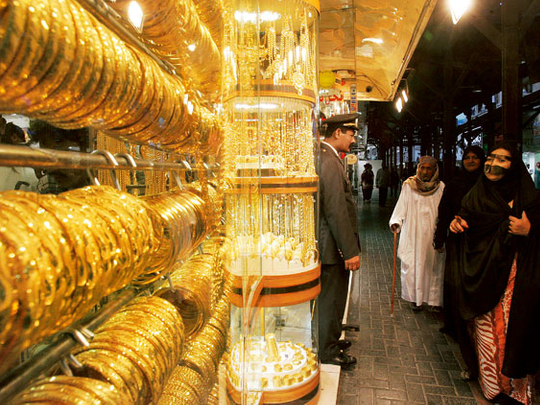
Wartime British Prime Minister Winston Churchill once said, “The optimist sees opportunity in every difficulty.” And optimists will have been rubbing their hands at the recent events in the gold market. While pessimistic investors have lamented at the record drops in the price of the precious metal, optimists have been buying it by the bars in a modern-day gold rush.
The enduring appeal of gold stretches back through thousands of years of human history. Faith in its value is unshakable. Although it hit its lowest level for decades in April at $1,345 (Dh4,940) per 28g (ounce) – down from a peak of almost $1,700 – the drop has not stopped people rushing to gold dealers and jewellers to buy more. Such is the draw of the metal that no one expects the price to stay low for long. In fact, the dip is seen by many as a good opportunity to stock up on one of the world’s most dependable commodities.
Brisk business
Across the Middle East and Far East, traders are reporting brisk business in response to the decrease in price. Firoz Merchant, chairman of Pure Gold Jewellers, says that now is the right time to invest. “There is no doubt that prices will rise again,” he says. “Gold is gold and it has no option other than to rise as historical projections have shown. Now is a good time to invest in and buy gold as the prices are lower.
“Gold has strong investment potential as always. The price drop has had a positive effect on business as more consumers are flocking to gold. Our business has recorded a growth of three times since the prices dropped.”
In Malaysia demand has been so high that there is now a shortage of gold bars and coins. Datuk Meer Sadik Habib, managing director of jewellery company Habib Jewels Sdn Bhd, says, “A lot of people are buying gold bars beside gold jewellery. The sale of gold bars has increased many-fold.”
While the drop has provided an opportunity for people hoping to invest in a commodity that has risen since 1998, market analysts have been scratching their heads trying to work out why prices took such a dramatic tumble.
One theory is that the slow economic recovery in China and the US, and the possibility that struggling nations in Europe will be forced to sell their gold reserves has led to the drop.
Gold prices dropped 8.5 per cent after reports from Beijing of a slowdown in growth and a downbeat April from US manufactures. The steep dip came at a time when the metal had already fallen to an 18-month low amid fears that cash-strapped nations would have to sell off bullion to prop up their economies.
Europe was rife with speculation that Cyprus would be first to sell off its reserves to raise €400m (Dh1.9 billion) and there were concerns that other struggling nations such as Spain and Portugal would follow.
London Times’ influential business editor Ian King wrote, “Many causes can be cited, from fears that the sale of Cypriot gold may be followed elsewhere in the eurozone – Italy is the world’s fourth biggest holder – to worries that the US Federal Reserve may curb its stimulus package. To that can be added falling demand from India – a big buyer – owing to import taxes and a weak rupee.”
Pure Gold’s Firoz believes speculators have played a large part in driving down the price. “In my opinion the drop in price is mostly due to speculators making exchange-traded fund sales,” he says. “The USA wants the dollar to be stronger, as for the past four years the currency has become weak as the world’s major central banks all invested in gold. The USA’s current strategy will make the dollar stronger so consumers will lose their confidence in gold.”
Turning to gold
The value of gold may continue to drop for some time. History has proved that nothing can be taken for granted. Between January 1975 and September 1976 gold prices almost halved.
Experts believe that the bull market that saw prices rise has come to an end and we can expect an unpredictable market with a long-term upward trend. Jeff Rhodes, global head of precious metals and chief executive of INTL Commodities at the Dubai Multi Commodities Centre agrees. “We will transition from a bull market with occasional dips into a bear market with short recovering rallies,” he says.
As the world became less certain after the global downturn in 2008 and currencies such as the dollar and the euro struggled, central banks turned to gold for its perceived stability. Demand for gold rose in the East as the Chinese and Indian economies grew, and in 2009 the Indian central bank bought 200 tonnes of gold from the International Monetary Fund. These factors combined to create a modern-day gold rush, which saw prices rise so fast that prospectors headed to gold-rich areas such as the Yukon in Canada and Alaska attempting to make their fortunes.
It’s easy to see why gold is so valuable. It’s relatively scarce and quite difficult to extract from the earth. With such qualities, added to the fact that it is portable, gold has become a secure vehicle favoured by many as a way of protecting wealth.
Experts recommend that gold should form part of a varied portfolio, as it remains a universal currency held by every central bank of note in the world. However, in the same way that the family home should not be regarded as an investment, gold bullion should be seen as a form of saving for a rainy day or of financial insurance rather than an investment.
Ultimately gold is money. It is the perfect safe haven asset and a great way of ensuring wealth preservation and for passing wealth from one generation to the next.











